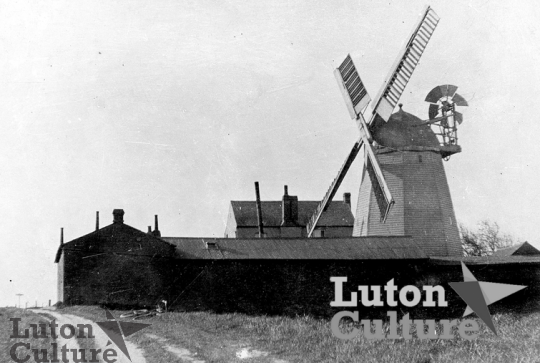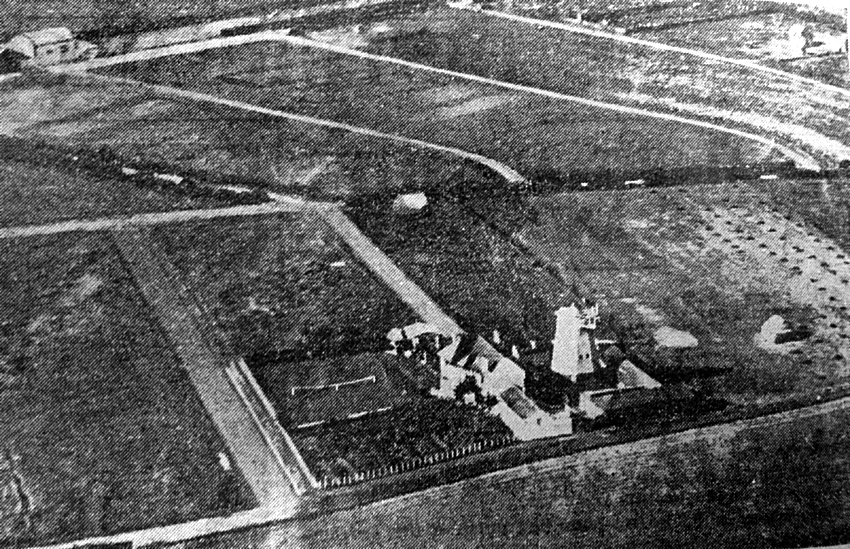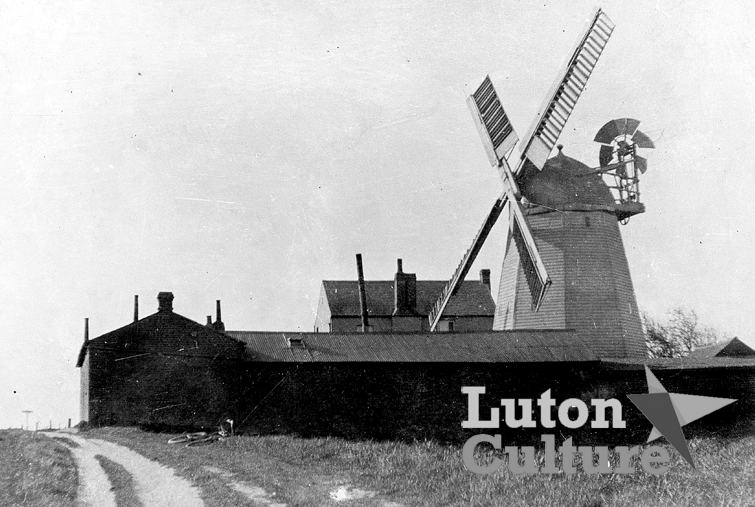Biscot windmill
Current Location
Classification
Source

- Photo: H. P. Wooding (1902).
Biscot windmill was a familiar backdrop to pictures taken at Biscot Camp during World War One. But the camp, laid out on roads intended to be used for housing, was a sign that an urban future was encroaching on the agricultural past. The following article was written by John Lea under the heading "Memories and records of Biscot Mill" and published in The Luton News on December 28th, 1956.
To the great majority of Luton residents Biscot Mill is probably just a name, but to an older generation it recalls a pleasant picture of a windmill which crowned the summit of rising ground rather less than a mile and a half from the Town Hall. Surrounded by big, open cornfields, with no trees intervening, the windmill was the most notable landmark for miles around, and for many years it occupied a place in the affection of Luton people akin, in lesser degree, to that they felt for the old Parish Church. It was a local institution, a fixed feature of the landscape.
From various points in the town it was possible to look northwards and see the mill at work, and it was an exhilarating sight to see the sails go round.
When one was close to the mill on a blowy day, the shrill whistling of the wind through the great sails, the gusto with which they swept round, and the accompaniment of various noises from the building, made the whole structure seem a thing of life.
Starting in New Bedford Road with the Moor Path, an open public footpath led to the mill, following pretty much the line of the present Biscot Road, and it continued down to Biscot and Limbury.
Another and more rural footpath which began opposite the northern end of Wardown sports ground ran up up to the mill alongside a hedge gay with flowers and berries in their season. But in those days this path was considered much too far out to be used by townspeople unless they were really "out for a walk". It served for pedestrians coming down from Round Green along the narrow little Stockingstone Lane, across which ran the River Lea under a wooden footbridge, just as it entered the Bramingham Shott estate (now Wardown Park).
Vehicles approached the mill via Leagrave Road and Biscot Lane; part of the latter has been absorbed among new streets and the remainder continues as Bishopscote Road.
In his History Of Luton, William Austin states that Biscot Windmill originated in the reign of Queen Elizabeth I under a lease granted for a very long term of years. By the foreclosure of a mortgage the property came into the possession of Edward Wingate late in the sixteenth century.
The Wingate family was for centuries the leading family in the Harlington district, and it is of interest to note that Francis Wingate of Harlington House was the magistrate before whom John Bunyan was brought on his first arrest for preaching near Harlington in November 1660.
The Wingates owned the Manor of Biscot, including the windmill which stood on some half an acre of land in Windmill Field, an open field of the hamlet.
The earliest deed now existing related to the mill is dated December 24, 1711, the parties being Lady Anne Wingate, widow of Sir Francis Wingate Kt, late of Harlington, and Arthur Wingate, son and heir of Sir Francis of the one part and Isaac Freeman, of Biscot, miller of the other part.
The deed relates that an ancient windmill had stood there, and proceeds to make a stipulation which at the present day causes a smile of surprise, for Freeman and his successors were to rebuild the windmill and keep it in repair for a period of 500 years at a nominal rent of sixpence per year!
For some generations the Freeman family had other milling interests in Luton, including a windmill on Rye Hill (top of Cromwell Hill) and a water mill on the Lea known as the North Mill, near Mill Street, from which the street took its name.
On January 3, 1841, there was a terrible thunderstorm in Luton, and Biscot Windmill was struck by lightning and destroyed by fire. The mill was rebuilt, probably in 1844, and on August 7, 1855, baker William Drewett, of Park Street, Luton, became its owner.
The Quaker family of Drewett was well known in Luton in the nineteenth century. While in business as a baker, William Drewett was also an active minister in the Society of Friends. He died in 1856 at the comparatively early ago of 56, within seven months of his purchase of Biscot Mill.
There was a family of at least seven children, each of whom grew up with distinctive personalities. Mrs Drewett lived until her 87th year (1897), her widowhood thus lasting 41 years. There are still living people who remember her, for she made quite a reputation in Luton and district as a sort of unofficial doctor, She undoubtedly had a genuine gift for healing and during her long widowhood large number so people went to this competent little Quaker lady for advice and medicine.
Through the untimely death of the father the management of Biscot windmill fell upon the eldest son, William Drewett the second, and the mill remained in his hands for nearly 30 years. He was a man of public spirit who became an overseer for the parish of Luton and, later, chairman of the Luton School Board.
He was concerned in the steps which led to the town being incorporated as a municipal borough in February 1876, and was a successful candidate at the first election for councillors in May of the same year. He afterwards advocated the extension of Cheapside from Waller Street to Guildford Street.
He was a strong temperance man and a leading member of the Society of Friends in Bedfordshire and the adjoining counties.
In connection with the windmill, Mr Drewett had a shop in Cheapside for the sale of corn and products of the mill.
Working for him at the mill was a Limbury boy names Jabez Horton, who in due course was promoted to be an assistant in the Cheapside establishment. Eventually he took over the shop business from Mr Drewett and later widened its scope. After his death nearly 40 years ago, his two sons succeeded him. The short, rotund figure of Jabez Horton, the village boy who became a councillor and alderman of Luton, will be easily recalled. There was often a twinkle in his eye, for he had a lively sense of humour, and his witty retorts frequently brightened the proceedings in the council chamber. To help enliven the quiet Christmas season of half a century ago he placed in his shop window a clockwork contrivance in a glass case. It portrayed a cat reaching up its paw towards a pheasant, but just before the capture could be made an old woman opened her mouth and banged down a besom. It missed the frightened cat, of course, and so the little comedy was played over and over again.
In its issue dated October 20, 1882, the Luton Times and Advertiser reported that the Drewett family had offered Biscot Mill for sale by public auction, when it was purchased for £1,500 by Frank Chapman Scargill. It was stated at the sale that the nominal rent of sixpence per annum had never been paid within living memory.
Mr Scargill was a local solicitor who lived at Bramingham Shott. He became the first Clerk to the Borough Magistrates when the Bench was constituted in 1876, and later H.W. Lathom joined him as a partner: they both acted as Clerk to the Justices.
Like other successful Luton businessmen, Mr Drewett built a house at Harpenden for his family and himself, while still engaged in commerce in Luton. In later years they moved to the Isle of Wight, where Mr Drewett died.
During the 26 years which followed the sale of Biscot windmill, its two principal tenants were Mr J. Newland and Mr Albert Laird. Mr Newland had a reputation in the district for his shire horses. Mr Laird was at once miller, farmer and breeder of pedigree pigs, and it was in the latter capacity that he was best known. He regularly exhibited his pigs at agricultural shows and repeatedly carried off the honours. He left the mill for Manor Farm, Sundon, where he eventually died.
The windmill had been purchased by the late Mr Fred Plummer, a senior partner in the straw hat firm of A.J. Hucklesby and Co. He sold it in 1908 to Mr A. H. Tooley, a member of a family well known in Bedfordshire and Hertfordshire as farmers, millers and corn merchants.
Mr and Mrs Tooley began their married life at the mill, and it was their home for 30 years: they greatly improved the mill home and its immediate surroundings.
During their long occupation they saw the whole district transformed, for the streets and houses of Luton crept nearer and nearer until they reached and went beyond the mill itself.
Mr Tooley was the last man to work the mill as a windmill. He employed as his miller William Clark, who came from Swaffham, Norfolk. Mr Clark was a skilled millstone dresser and was one of the last workers in the declining industry.
Biscot mill ceased working as a mill about 1925* and later the sails were taken down.
Work was carried on in the body of the mill for some years by machinery driven by a gas engine, and at last, in 1938, the structure was finally demolished.
And that was the end of the grand old windmill, which, with its predecessors, had gallantly responded to all the winds of heaven the three and a half centuries.

- An aerial view of Biscot Mill as published in 1938 with a caption saying it was taken about 18 years earlier.
*The Tuesday Telegraph of February 25th, 1919, reported that the sails of Biscot windmill had been dismantled and the wind part of the mill had thereby gone probably for ever. "The writer's eyes will now scan and wander around the north-western horizon for those big white sails in vain, though for full three-score years they have been encouraged in that direction to behold a pleasant sight."
The imminent loss of the mill's sails was told in the Tuesday Telegraph of January 14th, 1919, with an article which read: "The introduction of modern machinery always has the effect of ousting the picturesque and beautiful, and we are sorry to hear that an instance of this will shortly be experienced in Luton. The old Biscot Windmill is to have its sails lopped off. In fact, to all intents and purposes, Luton will know it no more, for the woodwork has dilapidated to such an extent that it is in constant danger of collapse. So it has been decided to demolish the old plant and to run the mill by a gas engine."
Object Location
Author: Deejaya



Add comment